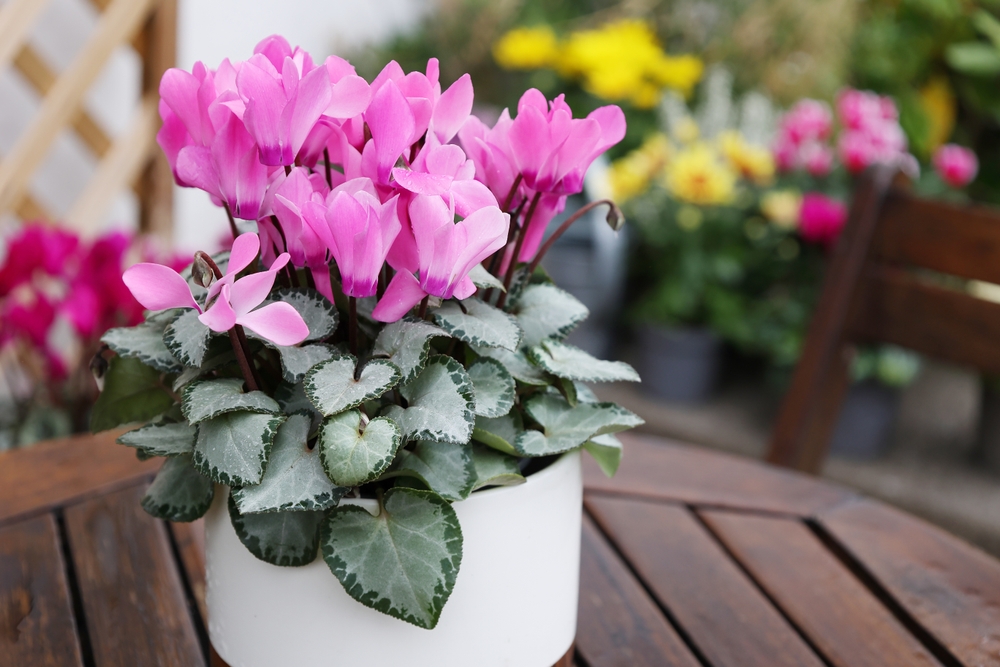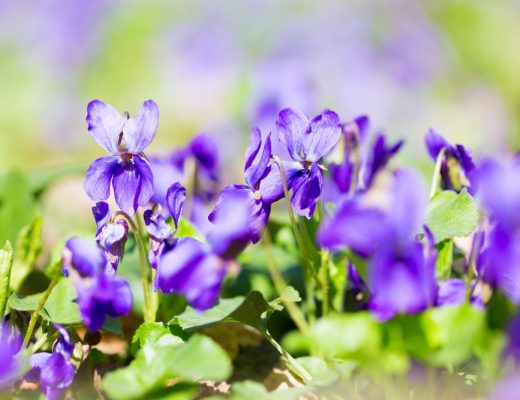When you think of winter and early spring flowers, you may imagine poinsettias, daffodils, and tulips. But have you heard of the cyclamen? These tuberous perennials put on a show in the colder months with colorful, butterfly-like flowers fluttering above heart-shaped leaves.
Since cyclamen are native to warm sections of the Mediterranean, they’re often grown as potted houseplants. Adding one of the plants to your home helps add life and color at a time when winter seems like it will never end. While cyclamen care isn’t complex, these plants have a few unique characteristics and requirements you should know about. Keep reading to learn how to care for cyclamen plants and keep them healthy.
What Are Cyclamen Plants?
While there are numerous cyclamen species, houseplant lovers often grow florist cyclamen (Cyclamen persicum). These tuberous perennials produce foliage and flowers in the winter and spring before going dormant for the summer. The tubers lay sleeping throughout the warmer months and then regrow each fall.
Since the plants are native to warm regions around the Mediterranean Sea, most of the United States is too cold for them to grow outdoors. However, they make fantastic houseplants.
When you provide proper cyclamen care, the plants reward you with beautiful heart-shaped leaves with silvery veins. Although the foliage is gorgeous on its own, most people grow these houseplants for their unique flowers. The plants send up numerous straight flower stalks topped with blooms that resemble butterflies with their wings up. The plant’s heart-shaped flowers and tendency to bloom near Valentine’s Day make them a popular gift for this holiday.
You can find cyclamen with all variations of white, red, and pink flowers, including bright fuchsia and deep burgundy. Some varieties even produce two-toned blooms.
How to Care for Cyclamen Plants Indoors
If you want to grow cyclamen as a potted houseplant, follow these care tips.
Choose a Suitable Container and Well-Draining Soil Mix
Since cyclamen rarely grow over eight inches tall, a small planter is best for these houseplants. Choose a container eight to ten inches in diameter, and ensure it has drainage holes that allow excess water to escape from the soil.
Once you’ve found a suitable container, fill it with a rich yet well-draining potting mix. Cyclamen plants prefer slightly acidic soil, so a houseplant potting mix with a peat moss base will work well. The peat moss will hold water and lower the pH, and materials like perlite or pine bark fines will provide drainage and aeration.
Provide Bright, Indirect Light
When your plant has leaves and is actively growing, place it in a location that receives bright yet indirect light. A few suitable locations include the middle of a bright room or beside a south-facing window covered with a sheer curtain.
If your house is cool enough to cause the plant to enter dormancy, move the dormant plant to a darker location. Complete darkness is acceptable but not necessary.
Water During Active Growth
Providing the right amount of water is key to proper cyclamen care. Your goal is to keep the potting soil moderately moist but not wet. If you’re using a well-draining potting mix, you can expect to water your plant once every one to two weeks.
Since temperature, humidity, and light impact how quickly the soil dries, not all growers should water on the same schedule. A better option is to monitor soil moisture and water when the top inch is dry. To check the moisture, you can stick your finger into the soil near the base of the plant.
Always water near the edges of the pot to keep the plant’s crown dry and safe from rot. Another option is to bottom water the plant by placing the pot in a shallow tray of water for an hour.
While the soil should remain moist when your plant has leaves and is growing, avoid watering it once it begins to enter dormancy. If you notice the plant losing leaves, stop watering.
Keep the Air on the Cooler Side
While many houseplants thrive in warm environments that mimic their tropical homes, flowering cyclamen plants prefer cooler temperatures. Keep the air between 60-65°F during the day and around 50°F at night. It’s okay if the temperatures are slightly outside this range, but avoid temperatures above 70°F since they interfere with bud and flower development.
Keep the plants away from hot and cold vents, which can cause sudden temperature changes and plant stress. Average household humidity is fine for cyclamen, so you don’t need to worry about spritzing the plants or using a humidifier.
Watch Out for Pests
Cyclamen plants are susceptible to attack from common houseplant pests like aphids, thrips, whiteflies, and spider mites. Although these pests vary in appearance, they are all small critters that use their specialized mouthparts to drink plant sap. If left untreated, they can cause yellow leaves and weak plants.
Since these pests quickly multiply, remove them as soon as you spot them. You can wipe the pests off your plant with a soapy rag or spray the pests with neem oil or insecticidal soap. Make sure to check new houseplants for signs of pests since this is the most common way these unwelcome guests enter your home.
Cyclamen Plant Care: Dealing with Dormancy
In the wild, cyclamen plants naturally go dormant during the warmer months. Sometime in the spring, the flowers drop, and the leaves fade. While this may seem alarming, the plants are just saving energy for the next growing season. When late summer or fall arrives, the tubers begin producing new growth.
Cyclamen plants also go dormant in most homes in the spring or early summer. So don’t worry if the plant’s leaves begin to wither or fall from the plant. Instead, stop watering and let the plant complete its natural cycle.
It’s up to you whether you want to keep your plant after the flowers and foliage fade. Many people toss the plants once they’re done blooming, but you can encourage them to regrow and rebloom with the proper care.
If you want to keep the plant, place the dormant, potted tuber in a cool, dark area. A mudroom, basement, or cupboard can all work well. Keep the soil drier than usual, but avoid letting it completely dry out. Check the plant once a week to monitor the soil moisture and look for signs of new growth. Once you see new leaves begin to emerge, move the plant to a warmer and brighter area, and resume normal watering.
Popular Cyclamen Varieties
If you’re not sure which type of florist cyclamen to choose, check out these popular varieties.
‘Sierra Series’: Known for large, vibrant blooms and sturdy growth, this series offers flowers from pure white to deep magenta.
Victoria’: This unique variety features ruffled, fringed petals and bicolor blooms in shades of pink or red edged with white.
‘Metis Series’: Compact and perfect for smaller spaces, this variety boasts numerous small blooms in bright colors.
‘Laser Series’: Known for its bold colors and vigorous growth, the Laser series has long-lasting flowers with smooth petals.
‘Mini Winter Series’: This dwarf variety thrives in cooler conditions and produces charming, dainty blooms.
‘Friller Series’: As the name suggests, this variety features frilly, intricately ruffled blooms in soft pastel and vibrant shades.
Brighten Your House with Plants and Flowers
Thanks to their cute foliage and beautiful flowers, cyclamen plants are a great addition to just about any home. And they make great gifts for lovers and friends alike! However, if you want a larger plant that provides year-round greenery, you can check out our other plant delivery options. We have trailing philodendrons ready to brighten up that empty shelf and small cacti perfect for a sunny windowsill.
After you pick out the best plant for you, make sure to read up on proper plant care. We’ve shared our plant knowledge by publishing articles on topics like caring for cat palm plants and the best rex begonia care guide.
Shop All



